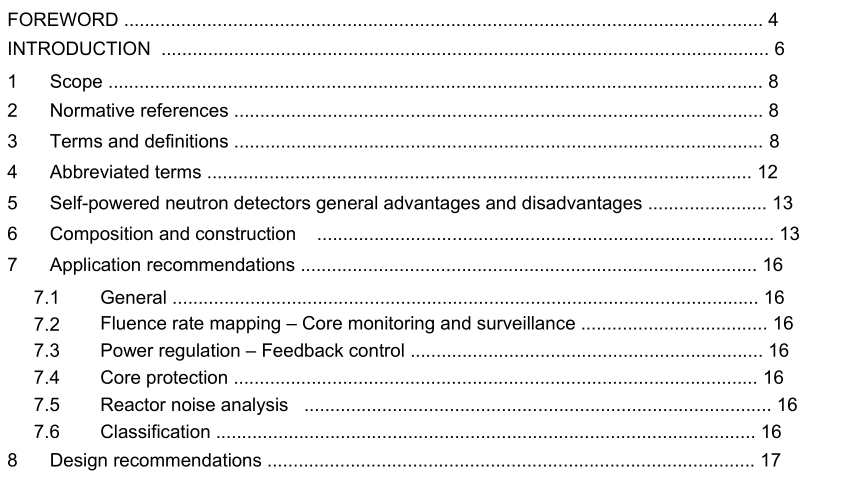IEC 61468-2021 pdf Nuclear power plants – Instrumentation systems important to safety – In-core instrumentation: Characteristics and test methods of self-powered neutron detectors

3.13 photoelectric effect complete absorption of a photon by an atom with the emission of an orbital electron [SOURCE: IEC 60050-395:2014, 395-02-08] 3.14 prompt response signal generation from a self-powered neutron detector based on the (n, γ, e) reaction 3.15 radioactive half-life time required for the activity of a radioisotope to decrease to half of its initial value Note 1 to entry: The radioactive half- life is related to the decay constant λ by the expression: T½= ln2/λ ≈ 0,693/λ. This quantity is expressed in seconds (s). [SOURCE: IEC 60050-395:2014, 395-01-12] 3.16 radioisotope isotope of an element with the property of spontaneously emitting particles or gamma radiation or of emitting X-radiation [SOURCE: ISO 5576:1997, 2.104] 3.17 self-powered neutron detector neutron-sensitive radiation detector that requires no external power supply, consists of three basic elements: an emitter that interacts with neutrons to emit electrons; a collector that collects these electrons and an insulator that isolates the emitter from the collector and converts the neutron fluence rate into electrical signal Note 1 to entry: See Figure 1 and Figure 2. 3.18 self-shielding self-absorption which occurs in the emitter: as emitter diameter increases, the escape probability of an electron born in the interior of the emitter decreases, and current-producing efficiency drops 3.19 in-core detector assembly mechanical arrangement for positioning different detectors inside the core of a nuclear reactor.
5 Self-powered neutron detectors general advantages and disadvantages In self-powered neutron detectors (SPNDs), the interactions of neutrons and atomic nuclei are used to produce a current which is proportional to the neutron fluence rate. The principles and characteristics of SPND design and operation are given in Annex A. When compared to other types of detectors, they have the following advantages: – no need of power supply; – simple and robust construction; – relatively small mechanical “size” well-suited for in-core installation; – good stability under temperature, pressure, radiation and other conditions. The main disadvantages of SPNDs are the low signal level and the inertia of the neutron component of the signal. 6 Composition and construction A typical SPND consists of an emitter, made of a material with a large neutron interaction cross-section, its surrounding insulator, collector and lead cable.
- Previous:IEC 61472-2-2021 pdf Live working – Minimum approach distances – Part 2: Method of determination of the electrical component distance for AC systems from 1,0 kV to 72,5 kV
- Next:IEC 61386-23-2021 pdf Conduit systems for cable management – Part 23: Particular requirements – Flexible conduit systems
- ISO IEC 27050-4-2021 pdf Information technology — Electronic discovery — Part 4: Technical readiness
- ISO IEC 27036-1-2021 pdf Cybersecurity — Supplier relationships — Part 1: Overview and concepts
- ISO IEC 27013-2021 pdf Information security, cybersecurity and privacy protection — Guidance on the integrated implementation of ISO/IEC 27001 and ISO/IEC 20000-1
- ISO IEC 26580-2021 pdf Software and systems engineering — Methods and tools for the feature- based approach to software and systems product line engineering
- ISO IEC 24735-2021 pdf Information technology — Office equipment — Method for measuring digital copying productivity
- ISO IEC 24711-2021 pdf Information technology — Office equipment — Method for the determination of ink cartridge yield for colour inkjet printers and multi- function devices that contain printer components
- ISO IEC 23544-2021 pdf Information Technology — Data centres — Application Platform Energy Effectiveness (APEE)
- ISO IEC 23510-2021 pdf Information technology — 3D printing and scanning — Framework for an Additive Manufacturing Service Platform (AMSP)
- ISO IEC 23127-1-2021 pdf Information technology — Learning, education, and training — Metadata for facilitators of online learning — Part 1: Framework
- ISO IEC 23126-2021 pdf Information technology for learning, education and training — Ubiquitous learning resource organization and description framework
- IEC 62620-2014 pdf Secondary cells and batteries containing alkaline or other non-acid electrolytes – Secondary lithium cells and batteries for use in industrial applications
- ISO IEC 19770-11-2021 pdf Information technology — IT asset management — Part 11: Requirements for bodies providing audit and certification of IT asset management systems
- IEC 60974-11-2021 pdf Arc welding equipment – Part 11: Electrode holders
- IEC 62430-2009 pdf Environmentally conscious design for electrical and electronic products
- IEC 60183-2015 pdf Guidance for the selection of high-voltage A.C. cable systems
- BS ISO IEC 15420-2009 pdf Information technology一 Automatic identification and data capture techniques EAN/UPC bar code symbology specification
- BS ISO IEC 19762.5-2008 pdf Information technology一 Automatic identification and data capture (AIDC) techniques – Harmonized vocabulary Part 5: Locating systems
- BS IEC 60860-2014 pdf Radiation protection instrumentation一 Warning equipment for criticality accidents
- ISO IEC 24735-2021 pdf Information technology — Office equipment — Method for measuring digital copying productivity
- ISO IEC 24711-2021 pdf Information technology — Office equipment — Method for the determination of ink cartridge yield for colour inkjet printers and multi- function devices that contain printer components